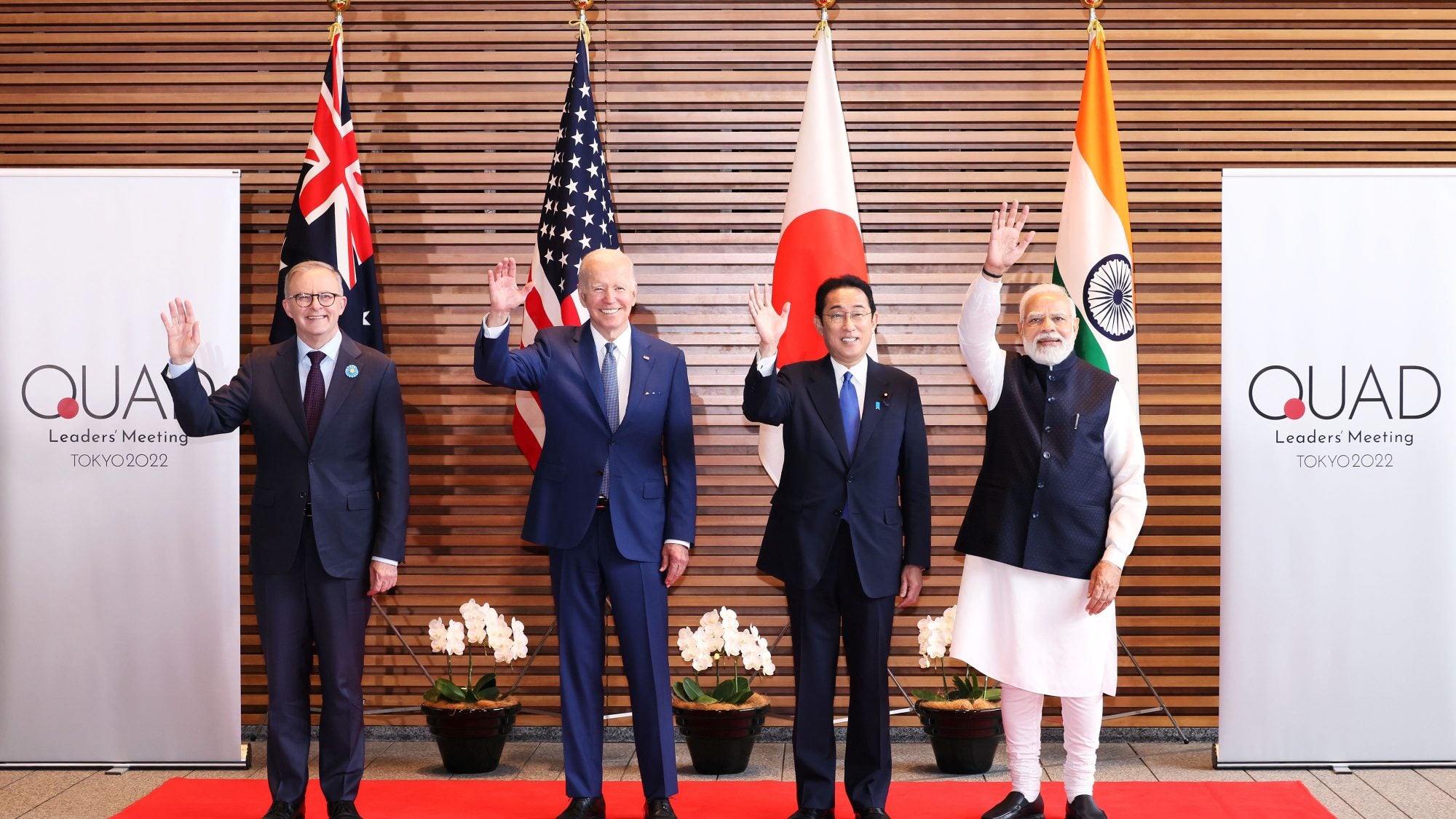
Title: Engagement, not Entanglement: India’s Relationship with the Quad
India is regarded as the “weak” link in the Quad—an informal strategic group with a focus on the Indo-Pacific region—largely because its policy actions (reluctance to embrace traditional security issues as a grouping, rejecting requests to undertake joint patrolling in South China Sea) do not align with the expectations of traditional external balancing and the formation of a firm military alliance. Understanding the nuances of Indian strategic calculations illuminates the rationale behind its external behavior and explains why the current form of the Quad serves New Delhi’s interests despite its “weak link” status. In this era of complex multipolarity, a foreign policy focusing on multi-alignment can be challenging. Questions remain if, in the long term, India can continue its status as a friend to all and enemy to none.
Understanding the Quad
As the geopolitics of the Indo-Pacific continue to dominate global headlines, discussions on the Quad remain rife. The concept of the Quad was sown in a function-based partnership when the United States, Australia, India, and Japan came together and formed the Tsunami Core group to address the deadly Indian Ocean earthquake and tsunami in 2004. The success of the diplomatic coordination instilled hope for a potential grouping of the four democracies to address regional challenges. Known incorrectly as the ‘Quadrilateral Security Dialogue’ in popular culture (the term remains absent in official documents or narratives, particularly after the Quad’s resurrection in 2017), the Quad is not a security or military grouping. It can best be described as a consultative grouping that seeks to shape the Indo-Pacific in a manner that is favorable to its members at a time when China is striving for regional dominance.
Since the Quad’s inception in 2007 and its resurgence in 2017, there has been a persistent debate on India’s role within the Quad. This is natural considering that India is the only country in the group that is not formally allied with the other members. This article seeks to explain the nuances of India’s foreign policy behavior and examines whether India’s current practice of aligning with multiple partners (at odds with each other) will be sustainable in the long term.
India’s Foreign Policy: Engagement Over Entanglement
New Delhi has traditionally been regarded, particularly in the West, as the “Quad’s weakest link” due to its reluctance to deepen defense cooperation. However, India’s worsening relations with China after the 2017 Doklam standoff and the 2020 border clashes bolstered New Delhi’s willingness to embrace the Quad. As such, in 2017, the Quad members convened at the under-secretary level; after Doklam, they also met at the ministerial level in 2019. The 2020 India-China standoff further deepened New Delhi’s bilateral and minilateral ties with the Quad members. In the same year, India accepted Australia’s request to join the Malabar Exercise, turning it into a de-facto Quad gathering. In 2021, the Quad transformed into a summit-level grouping compared to the assistant secretary level of their first meeting since 2007.
Despite its closer association with the Quad, India continues to be a reticent player in the traditional security realm. Although China’s increasing footprint in the Indo-Pacific region poses a direct challenge to all members of the Quad, India has been uncomfortable in framing the Quad as an anti-China grouping. Instead, New Delhi persistently propounds that the group is not “standing against something or somebody” but “stand[ing] for something.” Opposing a strong military alliance, India—and as a result, the Quad—prefers to prioritize non-traditional security issues: including maritime domain awareness, humanitarian and disaster relief, vaccine diplomacy, and cooperation on innovative technologies. This allows New Delhi to shape the region while retaining decisional autonomy and avoiding securitization, and diversifying relations through multiple partnerships.
Overall, India’s bilateral security ties with Australia, Japan (joint naval and army exercises, 2+2 Foreign and Defence Ministerial Meeting) and the United States (joint exercises, space situational awareness arrangement, initiative on critical and Emerging Technology) are deepening even as it resists a robust traditional security role for the Quad as a group. This signals India’s comfort with bilateral security cooperation to potentially deter China rather than following a collective course of action. As the Quad evolves with a more ambitious agenda—including cooperation in STEM research, regional infrastructure development, and climate change—India continues to nurture flexible partnerships with countries, including some that are antagonistic toward the Quad. India’s complex relationship with the Quad was brought into full display when New Delhi refused to condemn Moscow’s invasion of Ukraine while simultaneously making the assertion that “the use or threat of use of nuclear weapons is inadmissible” in conjunction with other Quad members in their latest joint statement. These “discrepant” choices have led many observers to brand India as “an anomalous Quad member.” US naval officer Chet Lee believes that India seems to be “hampering its overall effectiveness” of the Quad when being evaluated militarily. However, interpreting India’s actions through the lens of a regional “balancer” misses the nuances in its strategic thinking and resulting actions. Seen from alternative prisms, it is evident that the Quad in its current form serves India’s contemporary interests.
New Delhi’s approach towards China is one of limited balance. It chooses to follow a “cooperation-competition framework”: cooperation on areas of convergence and competition on areas of divergence. Prior to 2020, India adopted a relatively softer stance toward China’s growing assertiveness to preserve negotiation space. However, circumstances changed after the 2020 Galwan Valley row that led to the killings of 20 Indian soldiers and unspecified Chinese soldiers.
Having recognized the failure of its previous strategy, New Delhi has become increasingly proactive in “balancing” China, albeit indirectly. Research scholar Arzan Tarapore argues that Indian balancing behavior vis-à-vis China (particularly after 2020) is best explained by the concept of “zone balancing.” Instead of a dyadic confrontation, India seeks to shape the broader region by “build[ing] the capacity and resilience of third-party states to reduce the rival’s ability to coerce them.” However, the likely success of India’s zone balancing strategy remains debatable.
India’s History of Preserving Diplomatic Maneuverability
India’s security approach is shaped by a complex mix of material and ideational forces stemming from historical experiences, not just the balance of power. Its experience under British colonization for two centuries instilled a strong devotion to strategic autonomy: a prominent feature of India’s external policy since its independence in 1947. According to journalist Sreemoy Talukdar, strategic autonomy refers to the “exercise of choice driven purely by sovereign considerations and interest at the risk of accepting some costs.” These costs may include sanctions by certain quarters (as seen after the Indian nuclear tests), lack of diplomatic support during crisis, or alienation by other countries. During the Cold War, India adopted the non-alignment strategy to strengthen its autonomy. The leadership aimed to avoid entangled military relationships not of its choosing and allocate its limited resources to domestic needs and national development. By opting for this route, India attempted to minimize the influence of extra-regional actors in its areas of interest. It chose against falling into the United States or Soviet orbits by allying with one of them militarily.
In the 2000s, India emerged as a regional actor with a growing economic and security profile. The nation’s leadership replaced non-alignment preferences with a multi-alignment strategy. Its increasing influence in Asia has made it a valuable actor to different major powers, which allowed for great flexibility to align with multiple countries despite their conflicting interests. These engagements enable New Delhi to maximize its interest while minimizing the risks of formal alliances and potential military entanglements. Ultimately, this strategy supports India’s quest for a multipolar world wherein it remains one of the major poles. Hence, its partnerships with the west and engagement with China and Russia aligns with its rational calculation.
The Quad: Serving India’s interests
In view of the analysis above, it is easier to appreciate how the current form of the Quad aligns with Indian foreign policy behavior both in the past and present. First, a partnership with like-minded actors allows India to shape the region favorably while retaining decisional autonomy and flexibility to partner with multiple actors. Second, the Quad’s focus on non-traditional security issues allows India to establish itself as a “leading power” and provider of public goods in the Indo-Pacific—particularly in the Indian Ocean region. Third, India is cognizant that no single country can tackle the regional security challenges and realizes that it would be imperative to pool resources and capabilities to address the challenges. Fourth, by avoiding the “securitization” of the Quad, India gains more leeway to engage ASEAN countries without alienating them and sparking their fears amid a major power competition. Finally, the Quad enables India to pressurize China when needed while also avoiding antagonizing its northern neighbor beyond what is deemed a calculated risk.
How Sustainable is the Sweet Spot?
India is currently in a sweet spot with the capacity to balance the seeming contradictions in global politics and maintain partnerships with a diverse range of countries. It has managed to keep the CAATSA-related sanctions at bay even as it purchases Russian S-400 air defense missile systems with an eye on China and Pakistan. However, walking the thin line in the medium or long term may be difficult. As India-China relations worsen with heightened border standoffs and political tensions, it will be difficult for New Delhi to maintain its cooperation-competition dynamics with Beijing. Unlike the Cold War era—when New Delhi could afford to practice non-alignment as none of the superpowers posed a direct threat—it may be counter-productive to remain multi-aligned or un-aligned in a US-China competition scenario, especially at a time when China poses a significant security threat.
Moreover, the growing convergence between Russia and China as evident in their “no limits” partnership and military cooperation may aggravate its dilemma. India’s muted criticism of Russia relates to its fear of pushing Russia into China’s orbit. However, as Russia faces an uphill battle in its war against Ukraine, it is more likely to become a junior partner in the China-Russia equation. With such a development, New Delhi may not be able to sustain its current posture or gain much from it. In a nutshell, what seems like a sweet spot today may become increasingly uncomfortable tomorrow, especially with a stronger China-Russia-Pakistan military partnership. This is when India may have to accept a more “securitized” version of the Quad and adopt a more active security role lest it should be sidelined as an ineffective regional security actor.
. . .
Dr. Aditi Malhotra is the Editor-in-Chief of the Canadian Army Journal (CAJ) and a Fellow at the Canadian Global Affairs Institute. She is the author of Understanding Security Role Evolution of US, China and India: Setting the Stage, and India in the Indo-Pacific: Understanding India’s Security Orientation towards Southeast and East Asia. The views expressed in the article are those of the author and do not reflect the position or policy of the Government of Canada or the Canadian Armed Forces.
Image Credit: 首相官邸, Wikimedia Commons. CC BY 4.0
Recommended Articles

Moving forward, the NATO-Russia relationship will be characterized by deterrence in both the nuclear and conventional domains. NATO should focus on stabilizing its relationship with Russia by enhancing the credibility…

Artificial intelligence (AI) is now influencing every area of human life. The past decade has seen a drastic increase in the use of AI, including facial recognition software, self-driving vehicles,…

The United Nations Mission in Western Sahara (MINURSO) was founded in 1991 to oversee the ceasefire of a sixteen-year war as well as the self-determination referendum on the future of…